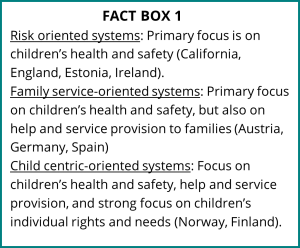NEW ARTICLE: Professor Marit Skivenes (UiB) and Professor Emeritus Rami Benbenishty (Hebrew University of Jerusalem and Bar Ilan University) finds that type of child protection system matters for populations’ trust in this study of nine high-income countries (Austria, California (USA), England, Estonia, Finland, Germany, Ireland, Norway, and Spain) published in the Journal of European Social Policy.[1]
This is the largest comparative study of citizens trust in the child protection system to date and displays distinct differences between populations in their level of trust in the child protection agencies, the frontline decision makers, and the judges making decisions about intrusive interventions. The differences follow type of child protection system in place in these countries, but confidence level is also in alignment with the general levels of trust in the police and the legal system.

Child protection systems (see Fact Box 1) are designed to protect children from harm or neglect and ensure that children have a quality of life independent of their family circumstances. However, child protection interventions are by nature invasive; they may significantly curtail or even terminate parental rights and responsibilities.
The consequences such interventions may have on the lives of parents and children thus underscores how important it is that the system itself enjoys a high degree of trust.
– Trust in the child protection system is not only imperative for legitimizing the formal and social power of this system but also for its ability to receive information volunteered by the public about children in vulnerable situations and for cooperation with children, families, and communities, states Marit Skivenes.
Highest levels of trust in child-centric systems
The findings indicate that the international typology of child protection systems carries merit. Citizen’s trust levels are indeed influenced by institutional context.
Citizens of risk-oriented systems, such as California (USA), England, Estonia, and Ireland, for example, displayed a significantly lower level of trust compared to family service-oriented systems, such as Austria, Germany, and Spain.
Furthermore, people in child centric-oriented systems, like Finland and Norway, appears to enjoy the highest levels of trust.
– These findings are important because they reflect citizen alignment with and influence from their own welfare state systems. This is a promising start and a finding that is worth further investigation, says Skivenes.
Do trust in the child protection system follow general trust levels?
The authors also find that trust levels in a country function as a form of anchor to some extent. In Austria, England, Estonia, Finland, Ireland, and Norway there is an alignment between the population’s overall trust in public administration, police and courts and confidence in the child protection system.
These findings were not without exceptions, however. In California and Germany, trust levels were markedly lower towards child protection systems compared to other public institutions.
– While we do not know exactly why this is the case, lower expectations of welfare state responsibilities in the US, and the large influx of unaccompanied minors, which may have overburdened the child protection system in Germany, could be potential explanations, suggests Skivenes.
It is also interesting to note that the converse relationship holds true for Spain. In this jurisdiction, findings indicate that trust in child protection system is actually higher than people’s general trust levels.
Children’s rights generally have a strong standing
Despite the fact that the article demonstrates variation in trust levels across high-income countries with different child protection systems, the authors conclude with one interesting and promising finding:
– A majority of respondents express confidence in their child protection systems and their decision makers. We believe this is showing that children’s rights have a strong standing in the studied countries, concludes Skivenes.
The article is accessible by clicking the link below.
[1] Skivenes, M. & Benbenishty, R. (2022) Populations trust in the child protection: A cross-country comparison of nine high-income jurisdictions. Journal of European Social Policy. May 2022.

